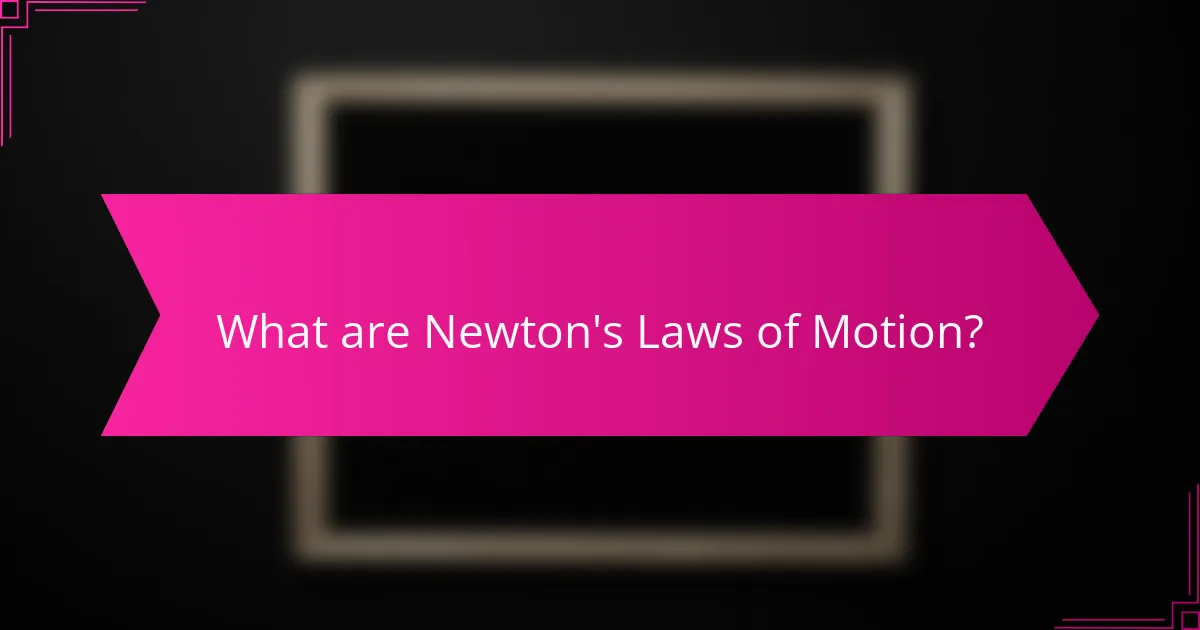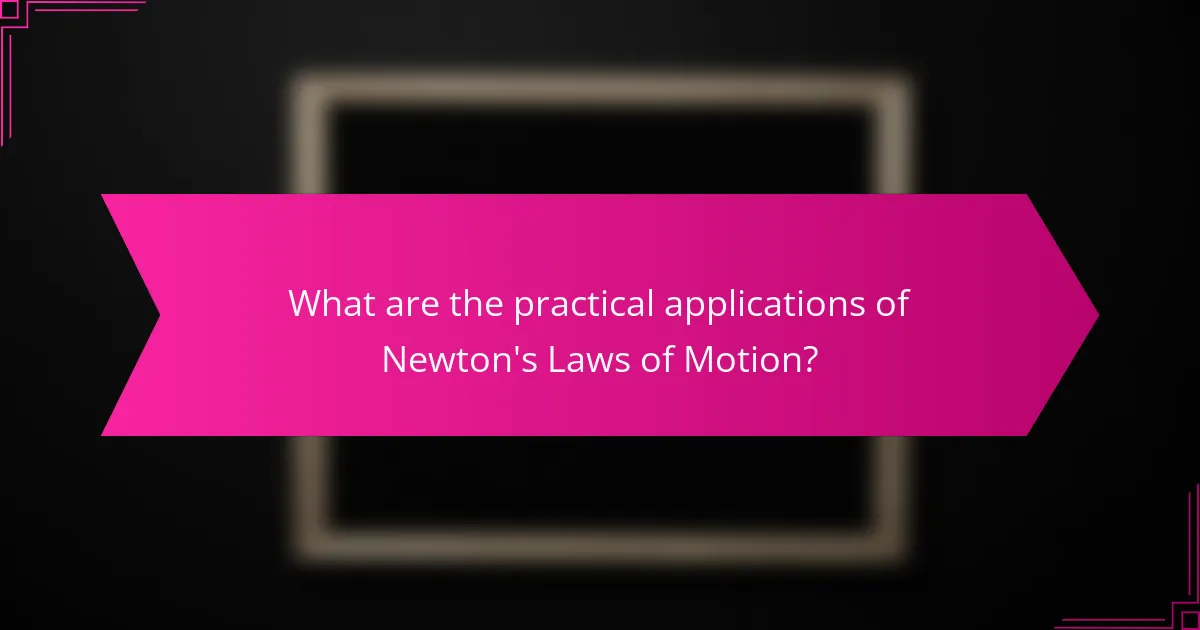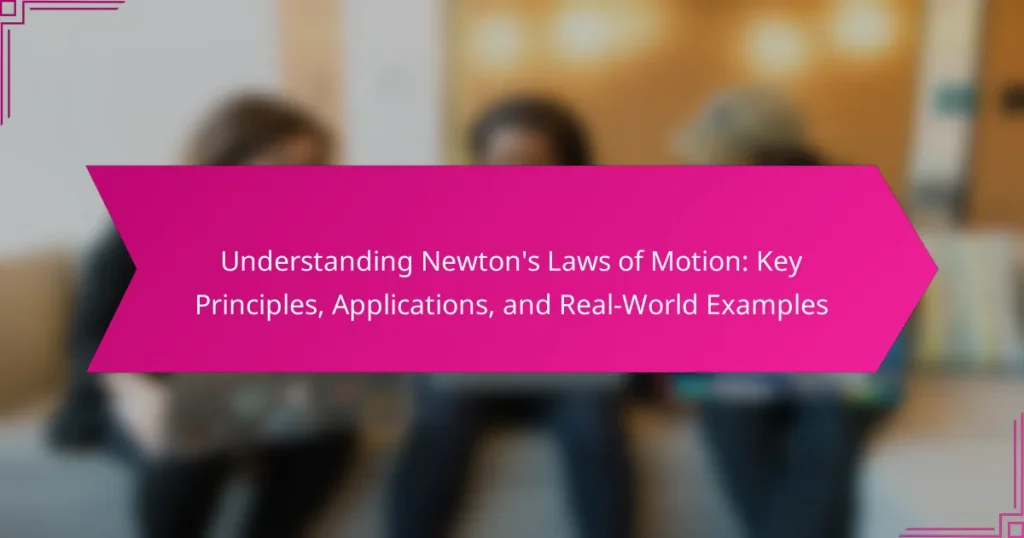Newton’s Laws of Motion are three foundational principles in classical mechanics that describe the relationship between the motion of an object and the forces acting upon it. The first law highlights inertia, stating that an object remains at rest or in uniform motion unless acted upon by an external force. The second law quantifies this relationship, expressing that acceleration is directly proportional to force and inversely proportional to mass, summarized by the formula F=ma. The third law emphasizes that for every action, there is an equal and opposite reaction, indicating that forces occur in pairs. These principles have extensive applications across various fields, including vehicle dynamics, sports performance, engineering, robotics, and space exploration, providing a framework for understanding motion in everyday scenarios.

What are Newton’s Laws of Motion?
Newton’s Laws of Motion are three fundamental principles that describe the relationship between the motion of an object and the forces acting on it. The first law states that an object at rest stays at rest, and an object in motion stays in motion unless acted upon by an external force. This principle emphasizes inertia, which is the tendency of objects to resist changes in their state of motion.
The second law quantifies the effect of force on an object’s motion. It states that the acceleration of an object is directly proportional to the net force acting on it and inversely proportional to its mass. This is often expressed with the formula F=ma, where F is force, m is mass, and a is acceleration.
The third law asserts that for every action, there is an equal and opposite reaction. This means that forces always occur in pairs; when one object exerts a force on another, the second object exerts a force of equal magnitude but in the opposite direction on the first object.
These laws were formulated by Sir Isaac Newton in the late 17th century and are foundational to classical mechanics. They provide a framework for understanding how objects behave in motion and are applicable in various real-world scenarios, from everyday activities to complex engineering systems.
How do Newton’s Laws describe the relationship between force and motion?
Newton’s Laws describe the relationship between force and motion through three fundamental principles. The First Law states that an object at rest stays at rest, and an object in motion continues in motion unless acted upon by a net external force. This highlights inertia, the resistance of any physical object to a change in its state of motion. The Second Law quantifies this relationship, stating that force equals mass times acceleration (F=ma). This means that the acceleration of an object is directly proportional to the net force acting on it and inversely proportional to its mass. The Third Law states that for every action, there is an equal and opposite reaction. This means that when one object exerts a force on another, the second object exerts a force of equal magnitude and opposite direction back on the first object. Together, these laws provide a comprehensive framework for understanding how forces influence the motion of objects in various contexts.
What is the significance of each of Newton’s three laws?
Newton’s three laws of motion are foundational principles in physics. The first law, the law of inertia, states that an object at rest stays at rest, and an object in motion remains in motion unless acted upon by a net external force. This law explains the concept of inertia and is significant in understanding how forces affect motion.
The second law states that the acceleration of an object is directly proportional to the net force acting on it and inversely proportional to its mass, expressed as F=ma. This law is crucial for calculating how forces influence the motion of objects and is widely used in engineering and physics.
The third law states that for every action, there is an equal and opposite reaction. This law highlights the interactions between objects and is significant in understanding propulsion and collision dynamics. Each law is essential for comprehending the behavior of objects in motion and forms the basis for classical mechanics.
How do these laws apply to everyday scenarios?
Newton’s Laws of Motion apply to everyday scenarios in various ways. The first law states that an object at rest stays at rest unless acted upon by an external force. For example, a book on a table remains still until someone picks it up. The second law explains how the acceleration of an object depends on the mass and the force applied. When pushing a shopping cart, it accelerates faster if it is empty compared to when it is full. The third law states that for every action, there is an equal and opposite reaction. This can be observed when jumping off a small boat; the boat moves backward as the person jumps forward. These laws are fundamental in understanding motion in daily life, from driving a car to playing sports.
Why are Newton’s Laws fundamental to physics?
Newton’s Laws are fundamental to physics because they describe the relationship between motion and forces. They provide a framework for understanding how objects behave under various conditions. The first law, the law of inertia, states that an object at rest stays at rest unless acted upon by a force. This principle lays the groundwork for analyzing motion. The second law quantifies the effect of forces, stating that force equals mass times acceleration (F=ma). This equation allows for precise calculations of how forces influence motion. The third law states that for every action, there is an equal and opposite reaction. This principle is crucial for understanding interactions between objects. Together, these laws form the basis for classical mechanics. They enable predictions of motion in everyday scenarios and complex systems. Their applicability spans various fields, from engineering to astronomy, making them essential to the study of physics.
What role do these laws play in understanding motion?
Newton’s laws of motion provide a foundational framework for understanding motion. They describe how objects behave when forces act upon them. The first law states that an object at rest stays at rest, and an object in motion stays in motion unless acted upon by a net external force. This principle highlights inertia and the concept of equilibrium. The second law quantifies the relationship between force, mass, and acceleration, expressed as F=ma. This law allows for the calculation of an object’s motion under applied forces. The third law states that for every action, there is an equal and opposite reaction. This principle explains interactions between objects. Together, these laws form the basis for classical mechanics, enabling predictions of motion in various scenarios, from everyday activities to complex engineering applications.
How have these laws influenced scientific thought?
Newton’s laws of motion have profoundly influenced scientific thought by establishing foundational principles of mechanics. These laws provided a systematic framework for understanding motion and forces. They challenged previous Aristotelian concepts of motion and laid the groundwork for classical physics. The first law introduced the idea of inertia, reshaping the understanding of how objects behave in motion. The second law quantified the relationship between force, mass, and acceleration, enabling precise calculations in mechanics. The third law emphasized action and reaction, influencing fields beyond physics, including engineering and astronomy. These principles have led to advancements in technology and a deeper comprehension of the universe. Historical figures like Einstein built upon Newton’s work, demonstrating its lasting impact on scientific theories.

What are the practical applications of Newton’s Laws of Motion?
Newton’s Laws of Motion have numerous practical applications in various fields. They are fundamental in understanding vehicle dynamics. For example, cars use these laws to ensure safety during acceleration and braking. In sports, athletes apply these principles to optimize performance and improve techniques. Aircraft design relies heavily on these laws for stability and control during flight. Engineering projects, such as bridges and buildings, incorporate these laws to ensure structural integrity. Robotics utilizes Newton’s laws for motion planning and control. Additionally, these laws are essential in space exploration for calculating trajectories and maneuvers. Overall, Newton’s Laws of Motion are integral to many aspects of modern technology and science.
How are Newton’s Laws utilized in engineering?
Newton’s Laws are fundamental in engineering for analyzing forces and motion. The first law, inertia, helps engineers understand how objects remain at rest or in uniform motion unless acted upon. The second law quantifies the relationship between force, mass, and acceleration, guiding the design of structures and mechanical systems. The third law, action-reaction, is crucial for propulsion systems and stability analysis. Engineers apply these laws in fields like aerospace, civil, and mechanical engineering. For example, aircraft design relies on these principles to ensure safe flight dynamics. Structural engineers use them to calculate load distributions and ensure safety and stability in buildings.
What specific engineering fields rely on these laws?
Mechanical engineering relies heavily on Newton’s Laws of Motion. This field applies these laws to analyze forces and motion in machines and structures. Aerospace engineering also depends on these laws for flight dynamics and vehicle design. Civil engineering utilizes these principles in structural analysis and load calculations. Automotive engineering incorporates Newton’s Laws to enhance vehicle performance and safety. Robotics engineering applies these laws to design and control robotic movements. Each of these fields demonstrates the fundamental importance of Newton’s Laws in practical applications.
How do Newton’s Laws affect design and safety in engineering?
Newton’s Laws significantly influence design and safety in engineering. The first law, inertia, ensures that structures remain stable under load. Engineers design to account for forces acting on objects at rest or in motion. The second law, F=ma, helps calculate the forces needed for acceleration. This principle guides material selection and safety factors. The third law states that every action has an equal and opposite reaction. This is crucial for understanding forces in dynamic systems. For example, in vehicle design, engineers consider crash forces to enhance safety features. Overall, Newton’s Laws provide a framework for predicting behavior and ensuring safety in engineering applications.
In what ways do Newton’s Laws apply to sports and physical activities?
Newton’s Laws of Motion apply to sports and physical activities in several key ways. The first law, the law of inertia, explains how athletes must overcome their body’s resistance to change when starting or stopping movement. For example, a sprinter must exert force to accelerate from a stationary position. The second law states that force equals mass times acceleration. This means that athletes can achieve greater performance by increasing their force output or reducing their mass. For instance, a weightlifter benefits from this principle by optimizing their technique to lift heavier weights efficiently. The third law, action and reaction, highlights that for every action, there is an equal and opposite reaction. This is evident in sports like basketball, where jumping off the ground generates upward force, allowing players to reach the basket. These principles are foundational in understanding motion and performance in various sports, from running to swimming.
How can athletes use these principles to improve performance?
Athletes can use Newton’s Laws of Motion to enhance performance by applying the principles of force, mass, and acceleration. The first law, inertia, helps athletes understand the importance of maintaining momentum during activities. For instance, a sprinter can optimize their start by minimizing resistance and maximizing acceleration. The second law quantifies how force affects acceleration. Athletes can increase their performance by applying greater force during movements, such as in weightlifting or sprinting. The third law emphasizes action-reaction pairs. Athletes can improve techniques like jumping or throwing by effectively utilizing the ground reaction force. By understanding and implementing these principles, athletes can enhance their training regimens and optimize their performance in various sports.
What are some examples of sports that illustrate these laws?
Examples of sports that illustrate Newton’s laws of motion include football, basketball, and gymnastics. In football, the law of inertia is evident when a stationary ball requires a force to initiate motion. Basketball demonstrates the action-reaction principle when a player pushes off the ground to jump. Gymnastics showcases acceleration as athletes use force to propel themselves through the air. Each sport relies on these fundamental laws to explain movements and interactions within the game.

What are some real-world examples of Newton’s Laws in action?
Newton’s Laws of Motion can be observed in various real-world scenarios. The first law, inertia, is demonstrated when a passenger in a car lurches forward during sudden braking. This occurs because the passenger’s body wants to remain in motion while the car stops.
The second law, which states that force equals mass times acceleration (F=ma), is evident when a small child pushes a large shopping cart. The child must exert more force to accelerate the heavy cart compared to a lighter one.
The third law, action-reaction, is illustrated when a swimmer pushes water backward to propel themselves forward. The force exerted on the water results in an equal and opposite force that moves the swimmer ahead.
These examples accurately reflect Newton’s principles in everyday life.
How do vehicles demonstrate Newton’s Laws during operation?
Vehicles demonstrate Newton’s Laws during operation through their motion and interactions with forces. Newton’s First Law states that an object in motion stays in motion unless acted upon by a force. For example, a car continues to move forward until the brakes are applied. Newton’s Second Law explains that the acceleration of an object is dependent on the net force acting on it and its mass. When a vehicle accelerates, the engine applies a force that overcomes inertia, resulting in motion. Newton’s Third Law states that for every action, there is an equal and opposite reaction. When a vehicle’s tires push backward against the road, the road pushes the vehicle forward. These principles are observable in everyday driving scenarios, confirming the validity of Newton’s Laws in vehicle operation.
What examples can be seen in cars, bicycles, and airplanes?
Cars, bicycles, and airplanes all demonstrate Newton’s Laws of Motion through their operation and design. For example, cars accelerate when the engine exerts force on the wheels. Bicycles move forward as the rider pushes the pedals, applying force to the chain and wheels. Airplanes generate lift due to the shape of their wings, which alters air pressure according to Bernoulli’s principle. Each vehicle relies on friction for traction; cars use tires on roads, bicycles depend on tire contact with surfaces, and airplanes utilize wheels during takeoff and landing. Additionally, all three types of vehicles experience inertia, which is evident when passengers feel a jolt during sudden stops or starts. These examples illustrate the practical applications of Newton’s Laws in everyday transportation.
How do safety features in vehicles relate to these laws?
Safety features in vehicles are designed to comply with laws related to vehicle safety and crashworthiness. These laws often mandate specific safety standards to protect occupants during collisions. For example, seatbelts and airbags are required in many jurisdictions to minimize injury in the event of a crash.
Newton’s laws of motion explain the forces acting on vehicles during acceleration, deceleration, and collisions. The first law, inertia, indicates that an object in motion will remain in motion unless acted upon by an external force. This principle underlines the importance of seatbelts, which restrain occupants and prevent them from being thrown forward in a crash.
The second law relates to the acceleration of vehicles and the forces involved in stopping. Safety features like anti-lock braking systems (ABS) help manage these forces effectively. ABS allows drivers to maintain steering control during hard braking, reducing the risk of accidents.
The third law states that for every action, there is an equal and opposite reaction. This principle is evident in crumple zones, which absorb energy during a collision, reducing the force transmitted to occupants. These features are often required by safety regulations, demonstrating the relationship between vehicle safety features and laws.
What everyday phenomena illustrate Newton’s Laws?
Newton’s Laws of Motion are illustrated by various everyday phenomena. A common example is a car accelerating or decelerating. This demonstrates Newton’s First Law, which states that an object in motion stays in motion unless acted upon by an external force. When a driver applies the brakes, the car slows down due to the frictional force acting on it.
Another example is a ball being thrown. This action shows Newton’s Second Law, which states that force equals mass times acceleration (F=ma). The harder the ball is thrown, the greater the force applied, resulting in higher acceleration.
Lastly, when a rocket launches, it exemplifies Newton’s Third Law. This law states that for every action, there is an equal and opposite reaction. The rocket pushes down on the ground, and in response, the ground pushes the rocket upward, allowing it to ascend.
How do simple actions like walking or throwing a ball reflect these laws?
Simple actions like walking or throwing a ball illustrate Newton’s Laws of Motion. Walking demonstrates the first law, where an object at rest remains at rest until acted upon by a force. The force exerted by the legs pushes the body forward. This action showcases inertia as the body continues moving until friction or another force stops it.
Throwing a ball exemplifies the second law, which states that force equals mass times acceleration (F=ma). The force applied by the arm determines the ball’s acceleration. A heavier ball requires more force to achieve the same acceleration as a lighter one.
Both actions also reflect the third law, which states that for every action, there is an equal and opposite reaction. When walking, the foot pushes down on the ground, and the ground exerts an equal force upward. When throwing a ball, the force exerted on the ball results in an equal force acting back on the thrower’s arm.
What are some surprising examples of these laws in nature?
Newton’s laws of motion manifest in surprising ways in nature. One example is the flight of birds. Birds use the principles of inertia and action-reaction to soar and change direction. Another example is the movement of planets. They follow elliptical orbits due to gravitational forces, illustrating Newton’s laws. A surprising instance is the behavior of a falling apple. It demonstrates gravitational pull and inertia when it falls to the ground. Additionally, ocean tides are influenced by the gravitational pull of the moon, showcasing the action-reaction principle. These examples highlight how Newton’s laws are fundamental to understanding natural phenomena.
What tips can help in understanding and applying Newton’s Laws?
To understand and apply Newton’s Laws, start with clear definitions of each law. Newton’s First Law states that an object in motion stays in motion unless acted upon by an external force. The Second Law defines the relationship between force, mass, and acceleration with the formula F=ma. The Third Law states that for every action, there is an equal and opposite reaction.
Practical applications help solidify these concepts. Conduct simple experiments, like rolling a ball to observe inertia. Use everyday examples, such as driving a car, to illustrate the laws in action. Visual aids like diagrams can clarify complex interactions.
Engaging with simulations or interactive models online can enhance understanding. Educational resources often provide visual representations of forces and motion. Collaborating with peers for discussions can deepen comprehension.
Reviewing historical experiments that illustrate these laws can provide context. For example, Galileo’s work on falling objects laid the groundwork for Newton’s principles. Regular practice with problems related to each law reinforces learning.
Newton’s Laws of Motion are three fundamental principles that explain the relationship between the motion of objects and the forces acting upon them. The article explores each law in detail, highlighting their significance in classical mechanics and real-world applications, including engineering, sports, and everyday phenomena. It also provides practical examples to illustrate how these laws govern motion, such as vehicle dynamics and athletic performance. Understanding these laws is essential for comprehending motion in various contexts, from simple actions like walking to complex engineering systems.


